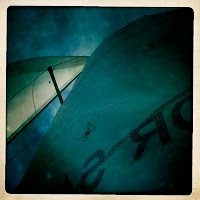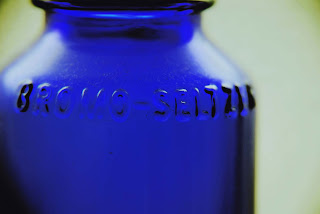Friday, December 31, 2010
Thursday, December 30, 2010
Wednesday, December 22, 2010
Saturday, December 11, 2010
Inspiration: "Scissors" Gallery
Scissors is one of many collections or online galleries of photos and images collected from various sources and updated on a regular basis. It's similar to the popular fffound.com, except its images are collected only by one person instead of a social network. I love Scissors because the curator Adam Miller usually chooses images that appeal to my aesthetic, that feel honest and visually interesting. Like fffound, Scissors does have a lot of imagery that I consider exploitative as well, but there are some gems amongst them. Both are a good resource for treatments and mood boards. Here's some of my recent favorites from Scissors (talk about a meta post).
Thursday, December 9, 2010
News and Media Part 3: Good Night and Good Luck
As part of my series on the state and future of media and news reporting, I’d love to add a plug for George Clooney’s 2005 film Good Night and Good Luck. If you haven’t seen it, you should. The film tells the story of CBS newsman Edward R. Murrow’s battle against Senator McCarthy and his witch-hunt in the 1950’s.
 Besides being lit meticulously and filmed beautifully, its message is clear and compelling: do not let fear and cowardice shout down the truth. An interesting message for a film that looks a bit like a polished film noir, with low light shots and interesting angles. Films noir, the stories of the human condition, our unfailing ability to sabotage our own happiness, inevitably ensuring we are evicted from the garden; seem at once so close and so far from Clooney's story of the height of honorable journalism ethics. This story probably the only thing on this earth that can make me seem nostalgic for the 1950’s.
Besides being lit meticulously and filmed beautifully, its message is clear and compelling: do not let fear and cowardice shout down the truth. An interesting message for a film that looks a bit like a polished film noir, with low light shots and interesting angles. Films noir, the stories of the human condition, our unfailing ability to sabotage our own happiness, inevitably ensuring we are evicted from the garden; seem at once so close and so far from Clooney's story of the height of honorable journalism ethics. This story probably the only thing on this earth that can make me seem nostalgic for the 1950’s.  It begs the question, what has happened that has caused the state of journalism to be so far from the right and honorable these days. The shattering of our societal consensus has certainly contributed to the fall in honor and respect held by the public for those who report the news, but they have also brought about their own downfall. In the 1950’s, disseminators of news sources were much more highly respected and people were much less skeptical. Now we take it for granted that there are many sides to the story and we only ever hear one. Not only that, but often there is no attempt at all to either tell the truth or even pretend to be unbiased. Commentary now passes for news. One wonders where this sense of duty to fight to show the public the truth has gone. Perhaps we no longer care to know it. Or are we all so jaded that we think there is nothing good and honorable in this world for which to take a stand anymore? But what is truth? We are exposed to so many different viewpoints now, that maybe we are of the mind that there is no absolute truth, and reality is not so immutable as it once seemed.
It begs the question, what has happened that has caused the state of journalism to be so far from the right and honorable these days. The shattering of our societal consensus has certainly contributed to the fall in honor and respect held by the public for those who report the news, but they have also brought about their own downfall. In the 1950’s, disseminators of news sources were much more highly respected and people were much less skeptical. Now we take it for granted that there are many sides to the story and we only ever hear one. Not only that, but often there is no attempt at all to either tell the truth or even pretend to be unbiased. Commentary now passes for news. One wonders where this sense of duty to fight to show the public the truth has gone. Perhaps we no longer care to know it. Or are we all so jaded that we think there is nothing good and honorable in this world for which to take a stand anymore? But what is truth? We are exposed to so many different viewpoints now, that maybe we are of the mind that there is no absolute truth, and reality is not so immutable as it once seemed.Previous Posts in News and Media:
News and Media Part 2: LA Times' "Ink Spots" Spot
News and Media Part 1: Review of Dennis McDougal's "Privileged Son"
Labels:
Film,
Media,
News and Media Series,
Review
Sunday, November 21, 2010
News and Media Part 2: LA Times' "Ink Spots" Spot
I remember see this spot and thinking it was graphically really cool. I actually really like all their print ads with the ink spot motif as well. I think using the ink evokes that feeling of realized creativity and accomplishment that a newspaper represents. Something has been created and you can hold it in your hand. To me this spot tries to say, not only is the LA Times relevant to Angelenos, but it is a work of art and scholarship.
LA Times "Ink Spot" from Süperfad on Vimeo.
Previous Posts in News and Media:
News and Media Part 1: Review of Dennis McDougal's "Privileged Son"
News and Media Part 1: Review of Dennis McDougal's "Privileged Son"
 Privileged Son: Otis Chandler and the Rise and Fall of the L.A. Times Dynasty the Micheneresque history of the LA Times written by former LA Times journalist Dennis McDougal is enlightening and an entertaining read. The book traces the story of the Los Angeles Times and the powerful family that owned it for over a century until its sale the Tribune Company in 2000. The dynasty that used its power, wealth, and influence to control the City of Los Angeles and its environs for nearly half a century was founded by staunchly anti-union newspaperman General Harrison Gray Otis and passed on to his acquisitive son-in-law with a rapaciousness that complemented his Protestant work ethic, Harry Chandler, the inspiration for Robert Towne's character Noah Cross in Chinatown. The book is very well written and much less sugar-coated, apparently, than numerous histories of the Times that have preceded it. For a resident of Los Angeles, I consider it no less than required reading if one wishes to understand this sprawling megapolis. So much becomes clear; just by understanding a detailed history of the Chandler family financial interests, one can trace the development or lack thereof of numerous components of this fair city including the LADWP, the LAPD, public transit, urban sprawl, the aerospace industry, the ports... The Chandlers had a hand in almost everything.
Privileged Son: Otis Chandler and the Rise and Fall of the L.A. Times Dynasty the Micheneresque history of the LA Times written by former LA Times journalist Dennis McDougal is enlightening and an entertaining read. The book traces the story of the Los Angeles Times and the powerful family that owned it for over a century until its sale the Tribune Company in 2000. The dynasty that used its power, wealth, and influence to control the City of Los Angeles and its environs for nearly half a century was founded by staunchly anti-union newspaperman General Harrison Gray Otis and passed on to his acquisitive son-in-law with a rapaciousness that complemented his Protestant work ethic, Harry Chandler, the inspiration for Robert Towne's character Noah Cross in Chinatown. The book is very well written and much less sugar-coated, apparently, than numerous histories of the Times that have preceded it. For a resident of Los Angeles, I consider it no less than required reading if one wishes to understand this sprawling megapolis. So much becomes clear; just by understanding a detailed history of the Chandler family financial interests, one can trace the development or lack thereof of numerous components of this fair city including the LADWP, the LAPD, public transit, urban sprawl, the aerospace industry, the ports... The Chandlers had a hand in almost everything. While the intrigue and corruption make for an interesting read, one through-line that appealed to me was the development of the Times as a paper and how it attempted to cover the news. During the lifetime of General Otis and Harry Chandler, the paper was merely a tool for controlling local politicians and a mouthpiece for their virulent anti-union, arch-conservative politics. Even with the control of the paper passing to Harry's son Norman, the paper remained a "Republican" paper. It was not until Norman's son Otis took control of the paper in 1960 that the Los Angeles Times attempted to emulate the New York Times in terms of quality. Intensely competitive, Otis Chandler wanted to have a good product and to him that meant critical recognition. Otis wanted Pulitzers and he wanted to beat the New York Times and for that he had to allow his paper to become a more "neutral" observer of society, and spend a lot more money hiring better reporters, comic artists, and opiners. This brings up the questions of what approach makes a paper "good," what sells, and what, if any, is the duty of journalists and publishers in publishing the news?
While the intrigue and corruption make for an interesting read, one through-line that appealed to me was the development of the Times as a paper and how it attempted to cover the news. During the lifetime of General Otis and Harry Chandler, the paper was merely a tool for controlling local politicians and a mouthpiece for their virulent anti-union, arch-conservative politics. Even with the control of the paper passing to Harry's son Norman, the paper remained a "Republican" paper. It was not until Norman's son Otis took control of the paper in 1960 that the Los Angeles Times attempted to emulate the New York Times in terms of quality. Intensely competitive, Otis Chandler wanted to have a good product and to him that meant critical recognition. Otis wanted Pulitzers and he wanted to beat the New York Times and for that he had to allow his paper to become a more "neutral" observer of society, and spend a lot more money hiring better reporters, comic artists, and opiners. This brings up the questions of what approach makes a paper "good," what sells, and what, if any, is the duty of journalists and publishers in publishing the news?
The 20th century saw a development of a set of codified journalism ethics that rely on objectivity and the public's right to know. However, with the newspaper business seemingly in trouble, it has brought into the public debate the questions above as well as those of "why are newspapers failing?" and "what will be the vehicles and platforms of news and media consumption in the future?" In a series of articles I intend to explore a number of these issues and at the risk of sounding like a media studies syllabus, I hope to delve into the following topics: the moral and civic "duty" of journalists, centrism vs. objectivity, and the fate of newspapers and future consumption platforms.
Labels:
Books,
Media,
News and Media Series,
Review
Thursday, November 18, 2010
Black Swan Review, In Spite of AFI
 So I printed my AFI ticket receipt for the Black Swan gala screening and reported to the box office within 90 minutes before the screening as instructed. The line to pick up tickets was really long, but all seemed well until someone with an AFI badge came over and told us if we had internet reservations we had to line up across the street. We moved across the street and lined up where the rush line was last year for the gala of The Imaginarium of Doctor Parnassus. A minor setback, but we thought all was well. An hour and a half later, we learned it was not. The AFI sent their volunteers out to disband the rush line and 10 minutes later to tell those of us with internet "tickets" that we weren't getting in. The story could end here, and there might be no review. Luckily, however, let's just say I know a ninja. We ended up watching the film from the reserved section of the overflow theater, which actually wasn't even full, and the seats were really comfy. Thanks AFI. Needless to say, I retract all I said about getting free tickets to AFI events. They are obviously not really committed to making film a "community event," as they claim they are. Maybe for the crappy films, when they are trying desperately to fill the theaters, but certainly not for the "galas." Anyway, enough venting.
So I printed my AFI ticket receipt for the Black Swan gala screening and reported to the box office within 90 minutes before the screening as instructed. The line to pick up tickets was really long, but all seemed well until someone with an AFI badge came over and told us if we had internet reservations we had to line up across the street. We moved across the street and lined up where the rush line was last year for the gala of The Imaginarium of Doctor Parnassus. A minor setback, but we thought all was well. An hour and a half later, we learned it was not. The AFI sent their volunteers out to disband the rush line and 10 minutes later to tell those of us with internet "tickets" that we weren't getting in. The story could end here, and there might be no review. Luckily, however, let's just say I know a ninja. We ended up watching the film from the reserved section of the overflow theater, which actually wasn't even full, and the seats were really comfy. Thanks AFI. Needless to say, I retract all I said about getting free tickets to AFI events. They are obviously not really committed to making film a "community event," as they claim they are. Maybe for the crappy films, when they are trying desperately to fill the theaters, but certainly not for the "galas." Anyway, enough venting. So there is one thing I should mention first: I missed about the first five minutes of the film, despite this, I think I can still write an informed review. Still, it feels difficult to start because I am not sure how much I can say without ruining the film. In the past I’ve been accused of saying too much. As a guideline, I will only discuss plot points that are in the trailer, so if you do not wish to watch the trailer or know anything about the film, stop reading. In my earlier description of the film, I said that the trailer left it unclear as to the genre of the film, however, I am going to classify the film as a psychological thriller. Similar to Aronofsky’s The Wrestler, Black Swan is a study of the psyche of an athlete/performer whose exacting and difficult chosen profession takes it’s toll both physically and mentally. Such a film depends entirely upon the lead actor to sell the story, and similar to the moving performance delivered by Mickey Rourke, Natalie Portman as Nina Sayers makes the film. The supporting cast are excellent, and complement her exceedingly well, but the weight of the film rests on her shoulders.
So there is one thing I should mention first: I missed about the first five minutes of the film, despite this, I think I can still write an informed review. Still, it feels difficult to start because I am not sure how much I can say without ruining the film. In the past I’ve been accused of saying too much. As a guideline, I will only discuss plot points that are in the trailer, so if you do not wish to watch the trailer or know anything about the film, stop reading. In my earlier description of the film, I said that the trailer left it unclear as to the genre of the film, however, I am going to classify the film as a psychological thriller. Similar to Aronofsky’s The Wrestler, Black Swan is a study of the psyche of an athlete/performer whose exacting and difficult chosen profession takes it’s toll both physically and mentally. Such a film depends entirely upon the lead actor to sell the story, and similar to the moving performance delivered by Mickey Rourke, Natalie Portman as Nina Sayers makes the film. The supporting cast are excellent, and complement her exceedingly well, but the weight of the film rests on her shoulders. Nina Sayers is a young ballerina in a prestigious New York ballet company. Seeking recognition and advancement, she longs for the lead role in the company’s opening ballet Swan Lake. Choreographer Thomas decides to give her the opportunity and attempts to mold her into the swan, white and black. The story is complicated by the passionate and wild Lily, a new addition to the company, whose very personality at once threatens and attracts Nina. As Nina attempts to perfect the role, the stress of conflicting and damaging influences in her life begin to grate upon her. Her anxiety and paranoia begin to consume her, though her dancing is still as technically perfect as it ever was. Nina’s battle with herself is the epic focal point of the film and Portman mesmerizes.
Nina Sayers is a young ballerina in a prestigious New York ballet company. Seeking recognition and advancement, she longs for the lead role in the company’s opening ballet Swan Lake. Choreographer Thomas decides to give her the opportunity and attempts to mold her into the swan, white and black. The story is complicated by the passionate and wild Lily, a new addition to the company, whose very personality at once threatens and attracts Nina. As Nina attempts to perfect the role, the stress of conflicting and damaging influences in her life begin to grate upon her. Her anxiety and paranoia begin to consume her, though her dancing is still as technically perfect as it ever was. Nina’s battle with herself is the epic focal point of the film and Portman mesmerizes. It’s unclear to what extent Aronofsky is responsible for the performance of Portman, not having observed the filming process, but it seems that everything about the film comes second to her. I have read that Portman and Aronofsky had been discussing the project for a very long time, so I think the cultivation of that relationship is his greatest triumph in the film. It is beautifully shot, with an appropriately dark color scheme, and the beautiful strains of Tchaikovsky’s Swan Lake carry the film musically, but something feels like it’s missing. I have not been able to put my finger on it, even days later, but when people ask me if it’s a good film, I find myself hesitating. One thing that surprised me about the film, were the horror film gimmicks employed by Aronofsky: cheap thrills provided by startling images and things that go bump in the night. At the time it seemed unnecessary, but looking back, I think it helped to add to the darkness that descends upon Nina. I think my main complaint is the weight of her anxiety is too much for the seductiveness required to truly make the film transcendent. It is anaphrodisiastic. This could simply be personal preference, but tending towards a high level of anxiety myself, to see it enacted so well on screen evoked a sympathetic response in me, leaving me feeling guarded and unreceptive. At times the film should have elated; it should have taken us on an emotional roller coaster ride, but I think it fell a little short.
It’s unclear to what extent Aronofsky is responsible for the performance of Portman, not having observed the filming process, but it seems that everything about the film comes second to her. I have read that Portman and Aronofsky had been discussing the project for a very long time, so I think the cultivation of that relationship is his greatest triumph in the film. It is beautifully shot, with an appropriately dark color scheme, and the beautiful strains of Tchaikovsky’s Swan Lake carry the film musically, but something feels like it’s missing. I have not been able to put my finger on it, even days later, but when people ask me if it’s a good film, I find myself hesitating. One thing that surprised me about the film, were the horror film gimmicks employed by Aronofsky: cheap thrills provided by startling images and things that go bump in the night. At the time it seemed unnecessary, but looking back, I think it helped to add to the darkness that descends upon Nina. I think my main complaint is the weight of her anxiety is too much for the seductiveness required to truly make the film transcendent. It is anaphrodisiastic. This could simply be personal preference, but tending towards a high level of anxiety myself, to see it enacted so well on screen evoked a sympathetic response in me, leaving me feeling guarded and unreceptive. At times the film should have elated; it should have taken us on an emotional roller coaster ride, but I think it fell a little short.Despite my complaints, the film is certainly one of the best of the year, and if you like any element of the film: Natalie Portman, Darren Aronofsky, psychological thrillers, or even ballet, you won’t be disappointed.
Sunday, November 7, 2010
AFI: "Black Swan" Gala
AFI is offering free tickets again this year to all the films. Check out the schedule for free tickets to the remaining films. Last year we attended three films without advance tickets, simply by waiting in the rush line, which I would recommend trying if you really want to see a film. Bellamy and Panique au Village were both really easy to get into, and we even got into Terry Gilliam's The Imaginarium of Doctor Parnassus via the rush line, but we had a long wait and horrible seats (though we still enjoyed the film). However, this year I was determined to take advantage and grab some tickets ahead of time. I checked the day they became available, but the ticket giveaways were closed. I thought I had missed it and would have to rush line again, but apparently they offer up free tickets at random for different movies on different days and with a little luck I scored a pair of tickets to the gala showing of Aronofsky's Black Swan with Natalie Portman and Mila Kunis. The trailer shifts from suggesting drama to psychological thriller to something supernatural. I'm not quite sure where it's all going, but in any case, expect a review next weekend.
Tuesday, November 2, 2010
Subscribe to:
Comments (Atom)











































